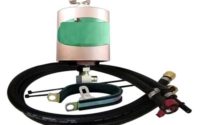Automotive Fuel Cells Market- Overview
Product Overview:
“Fuel Cells has made considerable progress and will be an essential asset as we push ahead in revolutionizing automotive electrification.”
A Fuel Cell is an electrochemical device that produces power without burning by joining hydrogen and oxygen to create water what’s more, warm.
How Fuel Cell Work?
The polymer electrolyte Membrane (PEM) is widely recognized kind of fuel cell for vehicle application. In a PEM fuel cell, an electrolyte film is inserted between a positive terminal (cathode) and a negative terminal (anode). Protons fly out through the layer to the cathode. Hydrogen is acquainted with the anode and oxygen (from air) to the cathode. The hydrogen atoms break separated into protons and electrons in view of an electrochemical response in the fuel cell catalyst.

Fuel Cell Electric Vehicles:
Fuel Cell electric vehicles (FCEVs) are fuelled by hydrogen. They are more proficient than ordinary conventional internal combustion engine vehicles and deliver no destructive tailpipe debilitate—they just radiate water vapor and warm air.
The United States Department of Energy is driving government and industry endeavours to make hydrogen-fuelled vehicles environmental friendly, reasonable and safe transportation alternative.
Global Automotive Fuel-Cell Market is projected to grow at a CAGR of over 14%, in volume terms during the forecast period backed on growing technological advancements and rising awareness regarding pollution and its injurious effects among consumers. Hydrogen segment of fuel cell market, has potential as compared to biogas, natural gas, methanol, and hydrocarbons and expected to maintain its dominance over the next five years.
United States Fuel Cell Market Overview:
According to U.S. Department of Energy, California has around 50 hydrogen fuelling stations open and some of them are in under development. California has more energy unit circulated control age than some other state, with more than 480 fuel cell systems, totalling more than 210 MW of power generation.
Major State Agencies, Organization and Key Policies related to Fuel Cell in California are:

According to U.S. Department of Energy, New York has around more than 180 countries that are part of the hydrogen and fuel cell industry. In 2017, in Bronx, a public hydrogen fuelling station will be opened. Toyota and Air Liquide’s hydrogen stations are under construction.
According to Plug Power, a fuel cell manufacturer, is adding a second shift with more 12 employees to double its production capacity at its Latham factory.
According to GE Fuel Cells, is expanding its business in Malta, New York. The company is planning to build a new site for 1-MW Fuel cells NYSERDA.
According to eZelleron, German portable fuel cell manufacturer, in April 2016, has opened a new office in Palo Alto, California to enter the U.S. fuel cell market.
Agreements and Partnerships:

Improvement of the hydrogen framework and new technological advancements in fuel cell industry are the key driver for the development of automotive fuel cell market. Since hydrogen is the essential fuel utilized as a part of power device electric vehicles (FCEVs), around 80 million tons of hydrogen is created each year to meet the developing requirement for hydrogen energy components in FCEVs.
Some of the major key players operating in Automotive Fuel-Cell are Toshiba, Ballard, Plug Power Inc., Panasonic, Delphi, Hydrogenics, Nuvera, Doosan Fuel Cell, SFC, WATT Fuel Cell, Ceres etc.
Conclusion: Global Automotive Fuel-Cell Market is projected to grow at a CAGR of over 14%, in volume terms during the forecast period backed on growing technological advancements and rising awareness regarding pollution and its injurious effects among consumers. The global fuel cell in the automobile market is exceptionally aggressive and is portrayed by the nearness of various SMEs and extensive players that strongly contend with each other to increase most extreme noticeable quality in this market. The presentation of new advancements and expanding interest in the market are the two huge elements that are required to heighten the level of rivalry between sellers.



